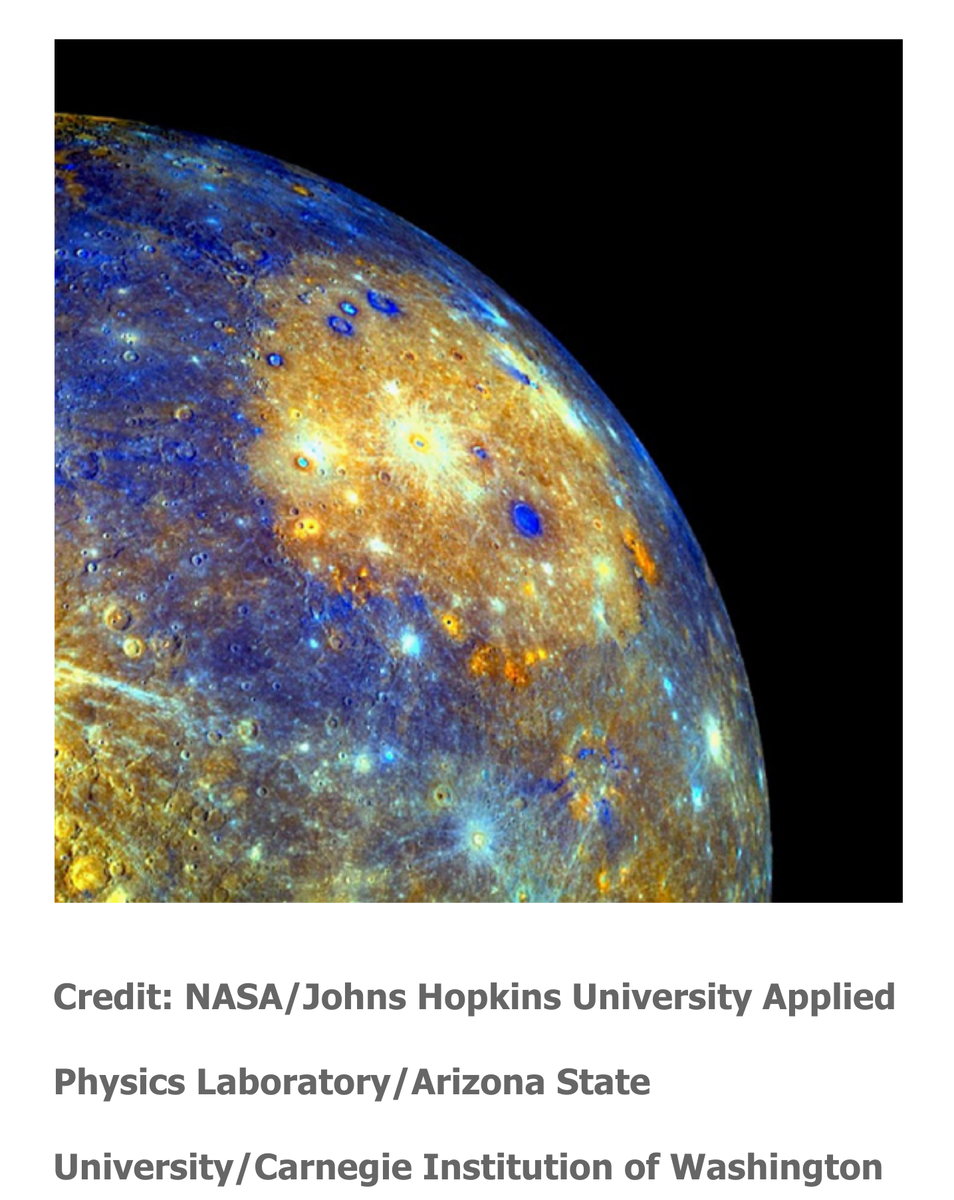[Mercury’s Anomalous Composition 水星の異常な組成]
Stephen Smith November 20, 2012 - 00:31Picture of the Day

Caloris Basin on Mercury.
水星のカロリス盆地。
――――――――
Nov 20, 2012
水星の画像は、その表面構造と薄い大気の中で鉱物化合物の異常なブレンドを明らかにします。
この惑星水星は直径4878キロメートルです。
この月衛星のガニメデとタイタンはどちらも大きく、地球の月はわずかに小さくなっています。
水星は平均距離57,910,000キロメートルで太陽を周回しています
―水星の1年はわずか88日続きます。
水星は58.6日ごとに自転するため、この惑星は太陽の周りの2つの軌道周回ごとに3回の自転を完了します。
太陽がその天頂にあるとき、その水星のプライマリ(主体たる中央)に近い温度が摂氏427度に達する可能性があることを意味します。
水星は(地球より)太陽に3分の2近いため、地球の表面に比べて平均9倍の放射線を受け取ります。
灼熱の熱と、太陽からの荷電粒子による激しい衝撃は、惑星科学者にジレンマをもたらします:
水星は薄いが検出可能な大気を持っています。
このように重力場が弱く(地球の38%しかない)、太陽放射による「侵食」が非常に多い惑星が、どのようにして大気の最小の残骸を保持できるのかは謎です。
土星の衛星タイタンについての前の写真で述べたように、弱い重力場は大気ガスが宇宙に漏れるのを防ぐことができないはずです。
古代の月衛星は、彼らがかつて持っていたどんなガスも太陽風によって放散されるべきだったので、空気のない砂漠であると考えられています。
イオンは、川岸を溶かす水の流れのように、ガスやほこりを引き離す傾向があります。
徐々に、大気密度は、気象爆撃やコロナ質量放出から表面を保護するために何も残っていない状態で、ゼロに落ちるはずです。
コンセンサス意見によると、そのため、非常に多くの月衛星が似ており、大気がないのです:
それらはすべて、数十億年にわたって同様の進化を遂げてきました。
タイタン、そして今のマーキュリー(水星)は、そのような推定を疑問視させています。
カッシーニ・ミッション・エンジニア達は、タイタンにはある種のガス発生器があり、その極寒のメタン大気を補充していると推測しています。
水星では、寒さが問題ではない場合、太陽風は粒子を表面の岩石から叩き出すのに十分強力であると考えられており、重力場によって弱く保持された軌道近くに浮遊してイオンを再結合させます。
この分子は存続できないので、MESSENGERのような人工衛星プローブは、月惑星へのフライバイ中に分子が(宇宙に)漏れるときのそれらを検出できます。
MESSENGERミッションはまた、広角カメラ(WAC)で11種類のカラーフィルターを使用して画像を作成しました。
赤外線、可視の赤、紫のフィルターからの情報を組み合わせて、任意の赤、緑、青のチャネルに通すことにより、水星の表面組成の偽色の印象を表示できます。
色は肉眼で見えるものではありませんが、地質学者達は、化学分布の変化や、さまざまな特徴が鉱物濃度とどのように相関しているかを視覚化できます。
たとえば、カロリス盆地は、周囲とは地質学的に異なる物質で構成されているように見えます。
盆地内の想定される衝突クレーターは、それらの縁と床が、完全に何か他のものでできています。
おそらく紺色の物質は、衝突後の火山の出来事から来たのか、あるいは私たちが見ているのは衝突物自身の残骸なのかもしれません。
現在、どの鉱物がどの色に対応しているかは誰にもわからないため、過去の出来事が何を引き起こしたのかを特定することは困難です。
2009年4月、NASAのTHEMIS人工衛星は、地球の磁気圏と太陽風の境界面で、地球から約60,000キロ上にある「電気的竜巻」を発見しました。
水星の最新のメッセンジャー・フライバイの間に、バークランド電流フィラメントをねじることにより、その磁場を太陽と直接接続する、同様のフラックス・チューブが見つかりました。
バークランド電流は、プラズマ物理学者や電気的宇宙の支持者達によく知られています。
それらは宇宙を通る宇宙送電線として機能し、プラズマを渦内に閉じ込めます、そして、電流が長距離を流れるようにします。
最近提案されたように、タイタンやマーキュリーのような天体を、賢明な太陽系の老人の住人であると見なすのではなく、サンダーボルツ「今日の写真」で長年詳細に説明されている異常を考えると、それらをダイナミックなアンサンブルの若々しいメンバーと考える方が合理的です。
水星は、おそらく比較的若い惑星であり、過去10、000年以内に現在の軌道と状況に到達した可能性があります。
もしその場合、そうすれば、どんな密度の大気の存在も驚くことではないでしょう。
水星に流れ込む電荷の存在は、それらの電流がはるかに強力だったかもしれない時期を示唆しています。
水星の歴史の中で、これらのらせん状の電流がグロー・モードまたはアーク・モードの段階にエネルギーを与えられた時期があった可能性があります。
それが起こったとしたら、水星の表面は、巨大な放電がクレーターを爆破し、広大な割れ目を切り、惑星の地殻の原子構造を広い領域に再配置するシーンだったでしょう。
カロリス盆地とクレーターの変化した物質は、水星の構造による電気エネルギーの増加が散逸した後に残されたものの一部である可能性があります。
スティーブン・スミス
――――――――
Nov 20, 2012
Images of Mercury reveal an unusual blend of mineral compounds in its surface structure, as well as a thin atmosphere.
水星の画像は、その表面構造と薄い大気の中で鉱物化合物の異常なブレンドを明らかにします。
The planet Mercury is 4878 kilometers in diameter.
この惑星水星は直径4878キロメートルです。
The moons Ganymede and Titan are both larger, while Earth’s moon is slightly smaller.
この月衛星のガニメデとタイタンはどちらも大きく、地球の月はわずかに小さくなっています。
Mercury orbits the Sun at a mean distance of 57,910,000 kilometers—a year on Mercury lasts a mere 88 days.
水星は平均距離57,910,000キロメートルで太陽を周回しています
―水星の1年はわずか88日続きます。
Since Mercury rotates every 58.6 days, the planet completes three rotations for every two orbits about the Sun.
水星は58.6日ごとに自転するため、この惑星は太陽の周りの2つの軌道周回ごとに3回の自転を完了します。
Close proximity to its primary means that temperatures on Mercury can reach 427 Celsius when the Sun is at its zenith.
太陽がその天頂にあるとき、その水星のプライマリ(主体たる中央)に近い温度が摂氏427度に達する可能性があることを意味します。
Being two-thirds closer to the Sun, Mercury receives an average of nine times more radiation at its surface than Earth.
水星は(地球より)太陽に3分の2近いため、地球の表面に比べて平均9倍の放射線を受け取ります。
The searing heat, as well as intense bombardment by charged particles from the Sun, pose a dilemma for planetary scientists:
Mercury has a thin but detectable atmosphere.
灼熱の熱と、太陽からの荷電粒子による激しい衝撃は、惑星科学者にジレンマをもたらします:
水星は薄いが検出可能な大気を持っています。
How a planet with such a weak gravity field (only 38% as great as Earth) and with so much “erosion” by solar radiation can retain the smallest remnant of an atmosphere is a mystery.
このように重力場が弱く(地球の38%しかない)、太陽放射による「侵食」が非常に多い惑星が、どのようにして大気の最小の残骸を保持できるのかは謎です。
As mentioned in a previous Picture of the Day about Saturn’s moon Titan, weak gravity fields are not supposed to be able to keep atmospheric gases from leaking away into space.
土星の衛星タイタンについての前の写真で述べたように、弱い重力場は大気ガスが宇宙に漏れるのを防ぐことができないはずです。
Ancient moons are thought to be airless deserts because whatever gas they once held should have long since been dissipated by the solar wind.
古代の月衛星は、彼らがかつて持っていたどんなガスも太陽風によって放散されるべきだったので、空気のない砂漠であると考えられています。
Ions tend to drag gases and dust away, like a stream of water dissolving a riverbank.
イオンは、川岸を溶かす水の流れのように、ガスやほこりを引き離す傾向があります。
Gradually, the atmospheric density should fall to zero, with nothing remaining to protect the surface from meteoric bombardment or coronal mass ejections.
徐々に、大気密度は、気象爆撃やコロナ質量放出から表面を保護するために何も残っていない状態で、ゼロに落ちるはずです。
According to consensus opinions, that is why so many moons look alike and why they have no atmospheres:
they have all undergone similar evolution over billions of years.
コンセンサス意見によると、そのため、非常に多くの月衛星が似ており、大気がないのです:
それらはすべて、数十億年にわたって同様の進化を遂げてきました。
Titan, and now Mercury, have called such presumptions into question.
タイタン、そして今のマーキュリー(水星)は、そのような推定を疑問視させています。
Cassini mission engineers have speculated that there is some form of gas generator on Titan, replenishing its frigid methane atmosphere.
カッシーニ・ミッション・エンジニア達は、タイタンにはある種のガス発生器があり、その極寒のメタン大気を補充していると推測しています。
On Mercury, where cold is not the issue, the solar wind is thought to be powerful enough to knock particles off the surface rocks, leaving the ions to recombine suspended in near orbit, weakly held by the gravity field.
水星では、寒さが問題ではない場合、太陽風は粒子を表面の岩石から叩き出すのに十分強力であると考えられており、重力場によって弱く保持された軌道近くに浮遊してイオンを再結合させます。
Since the molecules are not able to persist, satellite probes like MESSENGER can detect them during its planetary flybys as they leak away.
この分子は存続できないので、MESSENGERのような人工衛星プローブは、月惑星へのフライバイ中に分子が(宇宙に)漏れるときのそれらを検出できます。
The MESSENGER mission has also constructed images using eleven different color filters on its Wide Angle Camera (WAC).
MESSENGERミッションはまた、広角カメラ(WAC)で11種類のカラーフィルターを使用して画像を作成しました。
By combining the information from infrared, visible red, and violet filters, then running it through arbitrary red, green, and blue channels, a false-color impression of Mercury’s surface composition can be displayed.
赤外線、可視の赤、紫のフィルターからの情報を組み合わせて、任意の赤、緑、青のチャネルに通すことにより、水星の表面組成の偽色の印象を表示できます。
While the colors are not truly what would be visible to the unaided eye, they allow geologists to visualize the variations in chemical distribution as well as how various features correlate to mineral concentration.
色は肉眼で見えるものではありませんが、地質学者達は、化学分布の変化や、さまざまな特徴が鉱物濃度とどのように相関しているかを視覚化できます。
For example, Caloris Basin appears to be composed of geologically different material than its surroundings.
たとえば、カロリス盆地は、周囲とは地質学的に異なる物質で構成されているように見えます。
The supposed impact craters within the basin demonstrate that their rims and floors are made of something else entirely.
盆地内の想定される衝突クレーターは、それらの縁と床が、完全に何か他のものでできています。
Perhaps the dark blue substance came from volcanic events after the impacts, or perhaps it is the remains of the impactors themselves that we see.
おそらく紺色の物質は、衝突後の火山の出来事から来たのか、あるいは私たちが見ているのは衝突物自身の残骸なのかもしれません。
Presently, no one is sure which minerals correspond to which colors, so it is difficult to be certain of what past events caused what.
現在、どの鉱物がどの色に対応しているかは誰にもわからないため、過去の出来事が何を引き起こしたのかを特定することは困難です。
In April of 2009, NASA’s THEMIS satellites found “electrical tornadoes” about 60,000 kilometers above the Earth at the interface between Earth’s magnetosphere and the solar wind.
2009年4月、NASAのTHEMIS人工衛星は、地球の磁気圏と太陽風の境界面で、地球から約60,000キロ上にある「電気的竜巻」を発見しました。
During the most recent MESSENGER flyby of Mercury, similar flux tubes were found, connecting its magnetic field directly with the Sun through twisting Birkeland current filaments.
水星の最新のメッセンジャー・フライバイの間に、バークランド電流フィラメントをねじることにより、その磁場を太陽と直接接続する、同様のフラックス・チューブが見つかりました。
Birkeland currents are well-known to plasma physicists and Electric Universe proponents.
バークランド電流は、プラズマ物理学者や電気的宇宙の支持者達によく知られています。
They act as cosmic transmission lines through space, confining plasma within their vortices and allowing electric currents to flow over great distances.
それらは宇宙を通る宇宙送電線として機能し、プラズマを渦内に閉じ込めます、そして、電流が長距離を流れるようにします。
As was suggested in the recent past, rather than reckoning celestial bodies like Titan or Mercury to be geriatric denizens of a wizened Solar System, it is more reasonable, given the anomalies detailed for many years in the Thunderbolts Picture of the Day, to think of them as youthful members of a dynamic ensemble.
最近提案されたように、タイタンやマーキュリーのような天体を、賢明な太陽系の老人の住人であると見なすのではなく、サンダーボルツ「今日の写真」で長年詳細に説明されている異常を考えると、それらをダイナミックなアンサンブルの若々しいメンバーと考える方が合理的です。
Mercury is probably a relatively young planet and may have come to its present orbit and circumstances within the last 10,000 years.
水星は、おそらく比較的若い惑星であり、過去10、000年以内に現在の軌道と状況に到達した可能性があります。
If that is the case, then the presence of an atmosphere of whatever density would not be surprising.
もしその場合、そうすれば、どんな密度の大気の存在も驚くことではないでしょう。
The presence of electric charge flowing into Mercury hints at a time when those currents might have been far more powerful.
水星に流れ込む電荷の存在は、それらの電流がはるかに強力だったかもしれない時期を示唆しています。
There might have been a period in Mercury’s history when those helical currents were energized to the glow mode or the arc mode stage.
水星の歴史の中で、これらのらせん状の電流がグロー・モードまたはアーク・モードの段階にエネルギーを与えられた時期があった可能性があります。
If that happened, then the surface of Mercury would have been the scene of gigantic electric discharges blasting out craters, cutting vast chasms, and rearranging the atomic structure of the planet’s crust over large areas.
それが起こったとしたら、水星の表面は、巨大な放電がクレーターを爆破し、広大な割れ目を切り、惑星の地殻の原子構造を広い領域に再配置するシーンだったでしょう。
Caloris Basin and the altered materials in the craters could be part of what has been left behind after the increased electrical energy through Mercury’s structure dissipated.
カロリス盆地とクレーターの変化した物質は、水星の構造による電気エネルギーの増加が散逸した後に残されたものの一部である可能性があります。
Stephen Smith
スティーブン・スミス